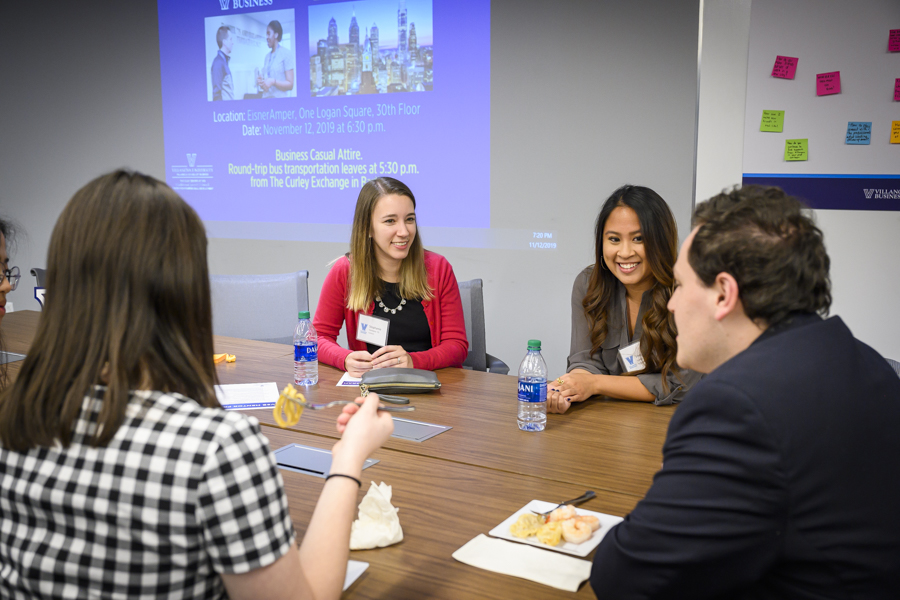
Students at Villanova University School of Business gather for a discussion at the O’Donnell Center for Professional Development. When it comes to artificial intelligence, employers wants candidates who can effectively use AI tools, but they certainly don’t want to read your AI cover letter.
When working with students at Villanova University School of Business, Kate Grady will often relay a conversation she had with an employer. For one open position, the employer had received hundreds to thousands of applications.
“It’s a competitive job market for business majors these days. You don’t want to use ChatGPT to generate the same cover letter that someone else is going to generate,” says Grady, associate director of experiential education and employer outreach at VSB’s O’Donnell Center for Professional Development.
“You are graduating from a great institution. You have a strong GPA, you were very involved in college, but you have a lot of the same credentials on your resume that you have on your cover letter. You have to stand out among hundreds or even thousands of people,” she says.
Almost every enterprising student these days uses artificial intelligence in their internship and job searches, whether it be for crafting resumes, writing cover letters, or researching particular career paths. The upside is that nearly every step in the job search is easier and more accessible. The downside is that it is easier and more accessible for everyone. If everyone writes a cover letter with ChatGPT to stand out, no one stands out at all.
And employers are starting to notice.
“I think that’s the potential danger of AI. It makes how you approach the job search process and the writing very generic. The whole point of the job search is the exact opposite: It’s about distinguishing your brand, making yourself stand out, and making it clear what your particular value add is,” says Brenda Stover, assistant dean at the O’Donnell Center.
“So if you become lazy with the use of Gen AI, I think you could be your own worst enemy.”
HOW EMPLOYERS FEEL ABOUT AI IN THE JOB HUNT
Think of a step in the job search process, and there’s likely a shiny new AI tool to help you through it. Platforms like Taletprice, Pyjama Jobs, and Fortay claim to match your skills and experience with job posts that have your desired salary range, company culture, and other metrics on your wish list.

Kate Grady
AI resume optimizers help tailor your resume to specific jobs.
It’s not cheating the system to use these tools, it’s essential to staying competitive.
At VSB, every undergraduate student must complete the four-year career development curriculum called Backpack-to-Briefcase. In it, students learn to use Big Interview’s Resume AI to get feedback on their resume for specific jobs, similar to the way employers use applicant tracking systems to do first-round resume reviews, Grady says.
Now, with the explosion of ChatGPT, Google’s Bard, and other language modeled generative AI, students are getting more help with those pesky cover letters and outreach emails.
In some cases, perhaps, too much help.
At the summer conference for the National Association for Colleges and Employers (NACE), several talent recruiters relayed stories of receiving three to five cover letters with identical paragraphs, Grady tells P&Q.
“There were a lot of recruiters who said they are starting to see (generative AI) in cover letters and on resumes. And they can tell when something is generated by ChatGPT or a similar technology,” Grady says.
“They don’t have a problem with students using it. But they have a problem when students are using it without consideration of their own authentic voice being part of the process. They want to ensure that students are giving them appropriate thought and consideration and using the tools ethically.”
Employers, in fact, want students to know how to use AI. Having curiosity about and adaptability to any new technology is a valuable workplace skill. Plus, the big promise of these kinds of generative AI tools is the increase in efficiency and productivity on the job. Employers want workers who can use AI, but not workers who use it without human interpretation or authenticity.
HOW B-SCHOOLS ARE ADAPTING TO GENERATIVE AI
Just a couple of months after ChatGPT was launched in November 2022, it passed the final exam of a prominent Wharton professor’s operations management course. It split open the debate on how the powerful tools should be used in business schools specifically and in higher education more generally.

Brenda Stover
Villanova School of Business implemented its Artificial Intelligence and Machine Learning minor a few years ago and opened courses up to any business school student. It also built AI and Writing for the Job Search content into its Backpack-to-Briefcase course, and developed a co-curricular student workshop on the topic. The school also is constantly evaluating what exposure its undergraduate business students have to AI tools.
“I think right now the pace of change with Gen AI is so rapid that it doesn’t lend itself to specific courses being developed and implemented quickly. In a lot of instances, faculty are eager to find particular topics they can embed the use of AI into their courses,” Stover says.
“We also encourage students to lean into co-curricular resources like our university-wide subscription to LinkedIn Learning which has some great courses centered around artificial intelligence.”
DOs AND DON’TS IN YOUR AI JOB SEARCH
For undergrads gearing up for those stressful internship and first-job searches, Poets&Quants asked Stover and Grady for their practical tips on using AI. Here’s their advice:
DO NOT ignore AI tools because you’re afraid of inauthenticity or because the sheer number may seem overwhelming.
DO experiment, explore, add tools that work for you, and eliminate ones that don’t. DO combine AI outputs with human intelligence.
“There are a lot of great use cases for AI,” Grady says. For example, she recently worked with a student who was interested in and had skills that strongly aligned with a particular industry, but the student didn’t really understand what the job was. Grady helped the student identify three possible career pathways.
The student then asked ChatGPT to explain the industry to her like she was five. From there, she told the AI bot that she wanted X,Y,Z in a possible career path, but she didn’t want A,B,C. ChatGPT gave her eight options (including the three Grady had suggested) to explore along with networking ideas with particular roles in the industry. Finally, Grady and the student talked about the pathways that were well suited for internships and which were later-level career opportunities.
“Again, it was using the tool for more exploratory purposes, but pairing it with guidance from an experienced professional.”
DO NOT copy and paste AI text into anything you’re sending out, whether that be a resume, email, or cover letter.
DO use AI to strengthen your own writing and to get those creative juices flowing. DO re-read what AI spits out and ensure that it fits your own voice, tone, and experience.
“Authenticity is central to the message that we’re sharing with students around the use of generative AI in their internship and job search,” says Stover. “Brass tacks, if you cut and paste, if you don’t add your authentic voice, it’s painfully obvious.”
DON’T MISS: WHAT DOES IT COST TO ATTEND A TOP 100 BUSINESS SCHOOL? AND BEST INVESTMENT BANKS TO WORK FOR IN 2024











Questions about this article? Email us or leave a comment below.